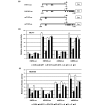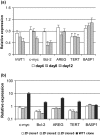The zinc finger domain of Wilms' tumor 1 suppressor gene (WT1) behaves as a dominant negative, leading to abrogation of WT1 oncogenic potential in breast cancer cells
- PMID: 17634147
- PMCID: PMC2206716
- DOI: 10.1186/bcr1743
The zinc finger domain of Wilms' tumor 1 suppressor gene (WT1) behaves as a dominant negative, leading to abrogation of WT1 oncogenic potential in breast cancer cells
Abstract
Introduction: There is growing evidence that the Wilms' tumor 1 suppressor gene (WT1) behaves as an oncogene in some forms of breast cancer. Previous studies have demonstrated that the N-terminal domain of WT1 can act as a dominant negative through self-association. In the studies presented here we have explored the potential for the zinc finger domain (ZF) of WT1 to also have dominant-negative effects, and thus further our understanding of this protein.
Methods: Using full-length and ZF-only forms of WT1 we assessed their effect on the WT1 and c-myc promoter using luciferase and chromatin immunoprecipitation assays. The gene expression levels were determined by quantitative real-time RT-PCR, northern blot and western blot. We also assessed the effect of the ZF-only form on the growth of breast cancer cell lines in culture.
Results: Transfection with WT1-ZF plasmids resulted in a stronger inhibition of WT1 promoter than full-length WT1 in breast cancer cells. The WT1-ZF form lacking the lysine-threonine-serine (KTS) insert (ZF - KTS) can bind to the majority of WT1 consensus sites throughout the WT1 promoter region, while the ZF containing the insert (ZF + KTS) form only binds to sites in the proximal promoter. The abundances of endogenous WT1 mRNA and protein were markedly decreased following the stable expression of ZF - KTS in breast cancer cells. The expressions of WT1 target genes, including c-myc, Bcl-2, amphiregulin and TERT, were similarly suppressed by ZF - KTS. Moreover, WT1-ZF - KTS abrogated the transcriptional activation of c-myc mediated by all four predominant isoforms of WT1 (including or lacking alternatively spliced exons 5 and 9). Finally, WT1-ZF - KTS inhibited colony formation and cell division, but induced apoptosis in MCF-7 cells.
Conclusion: Our observations strongly argue that the WT1-ZF plasmid behaves as a dominant-negative regulator of the endogenous WT1 in breast cancer cells. The inhibition on proliferation of breast cancer cells by WT1-ZF - KTS provides a potential candidate of gene therapy for breast cancer.
Figures







Similar articles
-
The WT1 Wilms' tumor suppressor gene product interacts with estrogen receptor-alpha and regulates IGF-I receptor gene transcription in breast cancer cells.J Mol Endocrinol. 2005 Aug;35(1):135-44. doi: 10.1677/jme.1.01761. J Mol Endocrinol. 2005. PMID: 16087727
-
Transcriptional activation of c-myc proto-oncogene by WT1 protein.Oncogene. 2004 Sep 9;23(41):6933-41. doi: 10.1038/sj.onc.1207609. Oncogene. 2004. PMID: 15286719
-
Suppression of prostate tumor cell growth in vivo by WT1, the Wilms' tumor suppressor gene.Int J Oncol. 2004 Mar;24(3):461-71. Int J Oncol. 2004. PMID: 14767530
-
Wilms tumor and the WT1 gene.Exp Cell Res. 2001 Mar 10;264(1):74-99. doi: 10.1006/excr.2000.5131. Exp Cell Res. 2001. PMID: 11237525 Review.
-
The role of the Wilms' tumour-suppressor protein WT1 in apoptosis.Biochem Soc Trans. 2008 Aug;36(Pt 4):629-31. doi: 10.1042/BST0360629. Biochem Soc Trans. 2008. PMID: 18631130 Review.
Cited by
-
Molecular update on biology of Wilms Tumor 1 gene and its applications in acute myeloid leukemia.Am J Blood Res. 2020 Oct 15;10(5):151-160. eCollection 2020. Am J Blood Res. 2020. PMID: 33224559 Free PMC article. Review.
-
The nephroprotective action of Passiflora edulis in streptozotocin-induced diabetes.Sci Rep. 2022 Oct 20;12(1):17546. doi: 10.1038/s41598-022-21826-9. Sci Rep. 2022. PMID: 36266308 Free PMC article.
-
Blocking the binding of WT1 to bcl-2 promoter by G-quadruplex ligand SYUIQ-FM05.Biochem Biophys Rep. 2016 Jan 14;5:346-352. doi: 10.1016/j.bbrep.2015.12.014. eCollection 2016 Mar. Biochem Biophys Rep. 2016. PMID: 28955841 Free PMC article.
-
Molecular mechanism of Wilms' tumor (Wt1) (+/-KTS) variants promoting proliferation and migration of ovarian epithelial cells by bioinformatics analysis.J Ovarian Res. 2023 Feb 24;16(1):46. doi: 10.1186/s13048-023-01124-2. J Ovarian Res. 2023. PMID: 36829196 Free PMC article.
-
A novel cell-penetrating peptide derived from WT1 enhances p53 activity, induces cell senescence and displays antimelanoma activity in xeno- and syngeneic systems.FEBS Open Bio. 2014 Jan 21;4:153-61. doi: 10.1016/j.fob.2014.01.007. eCollection 2014. FEBS Open Bio. 2014. PMID: 24490140 Free PMC article.
References
-
- Park S, Tomlinson G, Nisen P, Haber DA. Altered trans-activational properties of a mutated WT1 gene product in a WAGR-associated Wilms' tumor. Cancer Res. 1993;53:4757–4760. - PubMed
-
- Bruening W, Gros P, Sato T, Stanimir J, Nakamura Y, Housman D, Pelletier J. Analysis of the 11p13 Wilms' tumor suppressor gene (WT1) in ovarian tumors. Cancer Invest. 1993;11:393–399. - PubMed
Publication types
MeSH terms
Substances
LinkOut - more resources
Full Text Sources
Other Literature Sources
Medical

